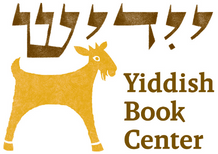Tokyo Storm Warning
In a glass display case in the stacks of the Yiddish Book Center is a curious volume called Great Jewish American Writers. It is open to a page about Isaac Bashevis Singer, and it’s intended to be a testament to his worldwide renown—because the volume, written by Hirose Yoshiji, was published in Osaka in 1993, and is, in fact, in Japanese.
This may strike many visitors as an exciting novelty. For me, a student of both Yiddish and Japanese, the discovery was absolutely titillating. I would soon find out, however, that Hirose’s book is far from the only commingling of these cultures in the Center’s collection.
The Steven Spielberg Digital Yiddish Library contains a number of books with Japan, Japanese culture, and/or Japanese literature as their subject matter. One particularly whimsical example is the 1921 Yaponishe mayselakh, or “Japanese Stories,” translated from the Japanese by M. Rokovski and revised by P. Kaplan. This volume contains six Japanese folktales told start to finish in Yiddish, and is complete with an illustration for each one, drawn in a style imitating traditional Japanese ukiyo-e woodblock prints.
Some of these stories—“The Lump,” “Two Frogs,” and “The Enchanted Mirror”—are well-known folktales. “The Lump” features a storm that keeps a woodcutter hiding in a hollow tree overnight, only to incidentally trap him at a wild demon party; “The Enchanted Mirror” tells of a young woman who, her mother having passed away, comforts herself with her own reflection, believing it to be her mother’s spirit. Others, though, are of mysterious origin, and the publisher did nothing to credit a source. Because of this, it’s impossible to know what parts were direct translation and what was embellishment added during the editing process, though I suspect there was much of the latter, since most of these stories run almost comically long.
In the case of “Two Frogs,” a tale about frogs who leave their respective homes in Kyoto and Osaka to see the world, a pivotal feature of most retellings is left out. When the frogs meet halfway atop a mountain, they give one another a boost up to better see their destinations. But because of the position of their eyes atop their heads, they are supposed to accidentally gaze backwards at their own cities. The Yiddish version omits this detail entirely, so that when the frogs conclude, “Kyoto looks just like Osaka!” “Osaka looks just like Kyoto!” and decide there is no point in continuing on their journeys, the humor is tragically lost. Which is truly a shame, because otherwise, Yiddish readers might notice a certain resemblance to the classic Chelm folktale about the man who (thought he) went to Warsaw.
Although not the most reliable source of Japanese folktales, Yaponishe mayselakh makes for an extremely enjoyable read, and its level is well-suited to intermediate students of Yiddish hoping to expand their repertoire.
A more advanced volume from Japanese in the Center’s stacks is Dray froyen poetn fun modernem yapan (“Three Woman Poets from Modern Japan”), a 1952 collection of translated short-form poetry by Yanagiwara Akiko, Yosano Akiko, and Kujō Takeko. And on a slightly different note, there is also O. Kurganoff’s Di amerikaner in yapan (“The American in Japan”), an original Yiddish journalistic account of the author’s time there shortly after World War II.
In the vein of Great Jewish American Writers, we also have a number of books written in Japanese about Yiddish culture. The most notable are perhaps the works of Ueda Kazuo, a linguist who has devoted much of his life to the Yiddish language, publishing a massive Japanese-Yiddish dictionary—the first such book—in 2010. Though the Center is not yet in possession of this dictionary, we do have three volumes of his work. These include a Yiddish grammar primer (Idisshu-go bunpō nyūmon/Araynfir in der yidisher gramatik) and a study published through a university journal titled “Yiddish Grammar in Brief” (Idisshu-go bunpō gairyaku).
A third piece of Ueda’s is in fact a reader for native Japanese speakers learning Yiddish (Idisshu-go tokuhon/Yidishe khrestomatye far yapaner). It contains three short stories by masters of Yiddish fiction—Avrom Reyzen, Y. L. Peretz, and Sholem Aleichem—in parallel text, Yiddish on one side and Japanese translation on the other. For a student like myself, this reader isn’t merely killing two birds with one stone, it’s a rare trans-lingual goldmine, and a gift I never expected to receive.
But it's true that intersections between these two cultures and languages are altogether not quite as few and far between as may be expected. Beloved musical Fiddler on the Roof has been beloved in Japan nearly as long as it has in the United States. In the past few decades, a number of enthusiasts in Japan have also started musical groups skilled in klezmer, such as Orkestar Dreydel and Jinta-la-Mvta. Even Yiddish language classes have recently become available at Tokyo and Osaka University.
It’s clear that the world of Yiddish has an interest in Japan, and the feeling appears to be mutual. In light of this, perhaps Hirose’s Great Jewish American Writers doesn’t need to be considered such a curious volume after all.
—Rebecca White
